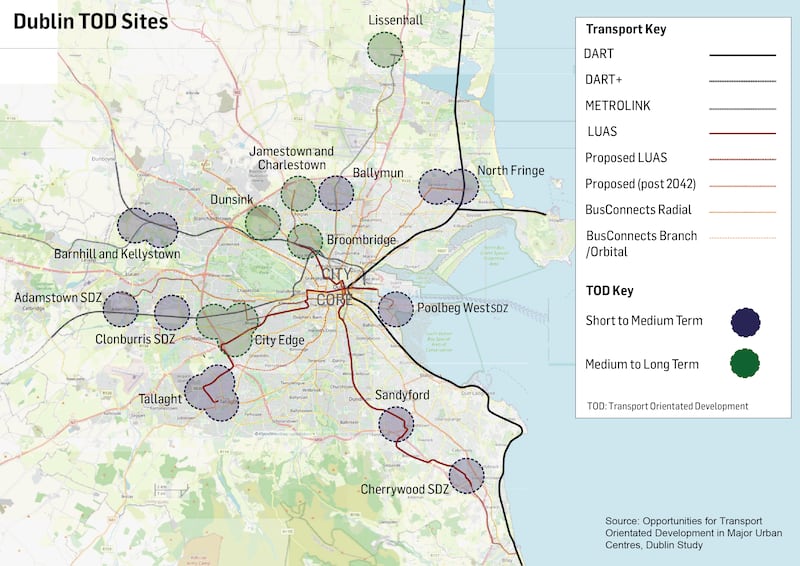Dunsink, formerly home to Dublin’s largest landfill, has been identified for “intensive” residential development, with the potential for more than 7,000 homes, under plans to capitalise on State investment in public transport.
The 435-hectare land bank, to the southwest of Finglas, is one of 14 locations around the capital which could deliver a total of 130,000 higher density homes, according to a report commissioned by the Departments of Housing and Transport.
The Transport Oriented Development report sets out the areas in Dublin city and county which should have significantly higher levels of housing due to their proximity to high-capacity transport, including existing rail and tram lines, and planned metro, Luas, Dart and BusConnects routes.
It includes areas that have already seen substantial development such as Ballymun, Tallaght, Adamstown and Sandyford, as well as undeveloped or former industrial “brownfield” lands such as the Poolbeg Peninsula, the “City Edge” lands along the Naas Road, and Dunsink.
READ MORE
Nine locations have been identified as having capacity for up to 60,000 homes in the “short to medium term” due to their proximity to existing high-capacity public transport, or schemes that will be delivered in the short term, by 2030, or medium term, by 2036, under the Transport Strategy for the Greater Dublin Area 2022-2042.
Up to 70,000 more homes are in locations in early stage planning or where future development will be dependent on the delivery of major public transport projects post-2036.
Ballymun has been earmarked for the early development of housing due to the proposed MetroLink underground rail line, due to open by 2035. While 3,500 new homes were constructed over the past two decades under a major regeneration plan following the demolition of the 1960s high-rise flats, Ballymun has the capacity for 8,190 more homes, the report says.

Despite ongoing regeneration since the 1990s, Tallaght town centre still has the capacity for up to 11,400 additional homes using the existing Luas Red line as well as proposed BusConnects routes.
Adamstown, under construction since 2004, is also in the short to medium development category, with potential for up to 6,000 more homes served by existing commuter rail, Dart+ upgrades and future BusConnects and Luas routes.
Nearby Clonburris, where construction has recently begun, is served by the same commuter rail and future Dart routes and could have up to 9,400 homes in the short to medium term.
To the south, Cherrywood could accommodate almost 7,000 more homes using the existing Green Luas line and future Luas upgrades. In nearby Sandyford, almost 2,700 more homes could be delivered in the short to medium term, again served by the Green line.
Despite having yet to see any residential construction, Poolbeg, at the city’s east end, is also grouped in the short to medium category with up to 3,500 homes earmarked for the old Glass Bottle site, which is expected to benefit from a Luas extension.
In the west of the city, the lesser known Barnhill/Kellystown area, north of Lucan, is also as yet undeveloped, but is expected to deliver more than 2,700 homes in the short to medium term with existing commuter services and the proposed Dart+West line.
The largest number of homes expected in this category, 11,700, is at North Fringe, which straddles Fingal and Dublin City Council’s jurisdictions and is currently served by the Dart at Clongriffin with BusConnects, DART+ Coastal North and eventual Luas lines planned.
Dunsink is the long-term development category. Of the 435 hectares, 200 will be available for development, largely to avoid building directly on top of the old dump, described in the report as being “unsuited for intensive development”. The area already has the benefit of commuter rail with two nearby stations at Ashtown and Navan Road Parkway, with the proposed Dart+West and Luas extension to Finglas to allow for 7,000 homes.
The Luas to Finglas, which is expected to be completed by 2036, will also open up the Jamestown Industrial lands north of Finglas village for the development of up to 3,700 homes.
Similarly the industrial lands at Broombridge, south of Finglas, are already served by a Luas line and in the future will benefit from Dart+West and the MetroLink at Glasnevin, but the eventual capacity of these lands is yet to be determined, the report said.
At the northern end of the MetroLink line, Lissenhall, north of Swords, will have capacity for 7,000 homes. On the long-term list the report identifies the City Edge project, to redevelop the industrial lands around the Naas Road, with Luas, Dart and BusConnects routes as having the greatest potential for housing, with 43,000 potential homes.












